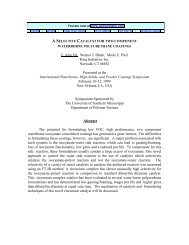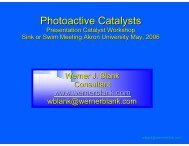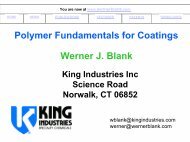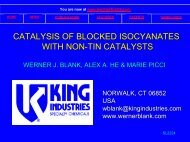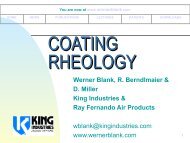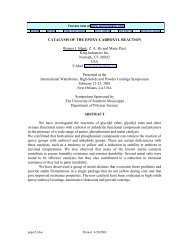Catalysis of the Isocyanate-Hydroxyl Reactions ... - Wernerblank.com
Catalysis of the Isocyanate-Hydroxyl Reactions ... - Wernerblank.com
Catalysis of the Isocyanate-Hydroxyl Reactions ... - Wernerblank.com
Create successful ePaper yourself
Turn your PDF publications into a flip-book with our unique Google optimized e-Paper software.
Both Bi oct. and AlCh1 behave similarly in <strong>the</strong> tack-free test as already shown in <strong>the</strong> gel test.<br />
(Figure 9).<br />
Dry-trough times for both ZIRC A and ZIRC B are about equal and approximately at an equal<br />
metal level four times faster than for DBTDL. On a <strong>com</strong>parative basis, <strong>the</strong> dry-through times for<br />
Bi oct. and DBTDL are substantially slower but still acceptable for many applications. In<br />
subsequent experiments it was determined that <strong>the</strong> cure response <strong>of</strong> <strong>the</strong> Bi oct. catalyst could be<br />
substantially enhanced by choosing a less polar solvent. Bi oct. demands a ra<strong>the</strong>r non-polar<br />
environment to assure good catalytic activity. This exceptionally fast reaction with ZIRC B<br />
suggests that this catalyst can be used in plural <strong>com</strong>ponent spray applications where mixing <strong>of</strong><br />
<strong>the</strong> isocyanate and <strong>the</strong> polyol takes place at <strong>the</strong> gun. O<strong>the</strong>r applications are in <strong>the</strong> RIM area.<br />
Potlife <strong>of</strong> <strong>the</strong> Formulation<br />
For many applications batch mixing <strong>of</strong> <strong>the</strong> polyol and <strong>the</strong> polyisocyanate crosslinker is used in<br />
which case a reasonable potlife is required. In low solids coatings it is possible to achieve an<br />
acceptable potlife by using a lower functionality resin and a ra<strong>the</strong>r slow reaction system. Because<br />
<strong>of</strong> <strong>the</strong> lower concentration <strong>of</strong> functional groups at a low nonvolatile content <strong>the</strong> reaction rates in<br />
solution are ra<strong>the</strong>r slow. Upon solvent evaporation increase in <strong>the</strong> concentration <strong>of</strong> functional<br />
groups accelerates <strong>the</strong> reaction rates. Because <strong>of</strong> <strong>the</strong> much higher molecular weight <strong>of</strong> <strong>the</strong><br />
polymers used in low solids coatings only a low conversion <strong>of</strong> hydroxyl-isocyanate groups is<br />
required to built a sufficient crosslinked network to achieve a tack-free surface or dry through.<br />
In high solids coatings <strong>the</strong> concentration <strong>of</strong> functional groups in solution and in <strong>the</strong> film are very<br />
similar, we <strong>the</strong>refore cannot rely on a change in concentration to effect potlife and reactivity.<br />
Because <strong>of</strong> <strong>the</strong> lower molecular weight and also lower functionality <strong>of</strong> high solids coatings we<br />
also require higher conversions <strong>of</strong> functional groups to achieve tack-free and dry-through<br />
conditions.<br />
Addition <strong>of</strong> excess 2,4-pentanedione can improve <strong>the</strong> potlife as seen with ZIRC A catalyst.<br />
Fur<strong>the</strong>r improvements in potlife can be achieved with aluminum chelate (Alch1). Compared to<br />
DBTDL <strong>the</strong> potlife <strong>of</strong> a formulation can be substantially enhanced by addition <strong>of</strong> 2,4-<br />
pentanedione 24 . Both formulations were adjusted for an equal dry-through time <strong>of</strong> about 50<br />
minutes (Figure 12).<br />
Relative Reaction Rates <strong>Hydroxyl</strong>-Water<br />
As shown in Figure 13, n-butyl isocyanate preferentially reacts with <strong>the</strong> hydroxyl groups instead<br />
<strong>of</strong> water and <strong>the</strong> formation <strong>of</strong> polyureas is minimized in <strong>the</strong> presence <strong>of</strong> ZIRC A <strong>com</strong>pared to<br />
DBTDL. This selectivity <strong>of</strong> <strong>the</strong> isocyanate-hydroxyl reaction is not only <strong>of</strong> importance in <strong>the</strong><br />
evolving market for two <strong>com</strong>ponent water-borne isocyanate crosslinked coatings, but also in<br />
many high solids coatings. Blushing <strong>of</strong> high solids coatings at high humidity or even gassing is<br />
an <strong>of</strong>ten encountered problem with high solids isocyanate crosslinked coatings.<br />
Hydrolysis <strong>of</strong> ester group containing resins in <strong>the</strong> presence <strong>of</strong> dialkyltin catalysts is a problem for<br />
many polyester-urethane polymers on exposure to water. We have demonstrated that DBTDA<br />
and presumably, DBTDL, are very effective catalysts in increasing <strong>the</strong> hydrolysis <strong>of</strong> a polyester<br />
resin. Zirconium, aluminum chelate and also bismuth salts do not catalyze <strong>the</strong> hydrolysis<br />
reaction. This would indicate that <strong>the</strong>se catalysts can give improved resistance properties and also<br />
suggests <strong>the</strong>ir use in <strong>the</strong> preparation <strong>of</strong> polyurethane polymers.<br />
Because <strong>of</strong> <strong>the</strong> growing importance <strong>of</strong> water-borne two <strong>com</strong>ponent coatings we also investigated<br />
<strong>the</strong> use <strong>of</strong> a ZIRC B catalyst, since DBTDL gives very fast water reaction rates. In a high solids<br />
waterborne polyester/polyisocyanate coating a potlife <strong>of</strong> only 30 minutes is achieved with



